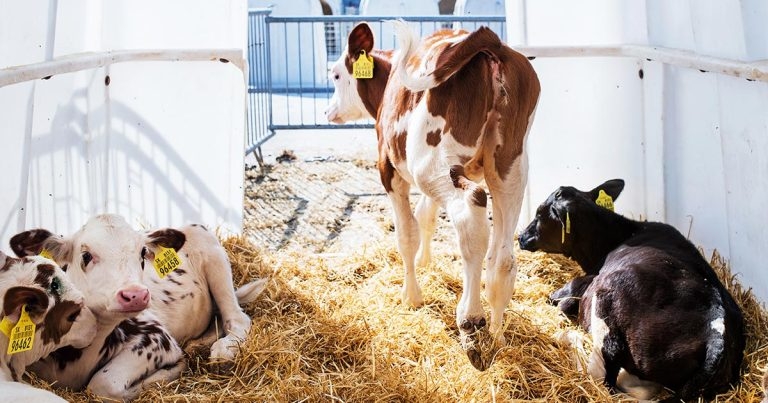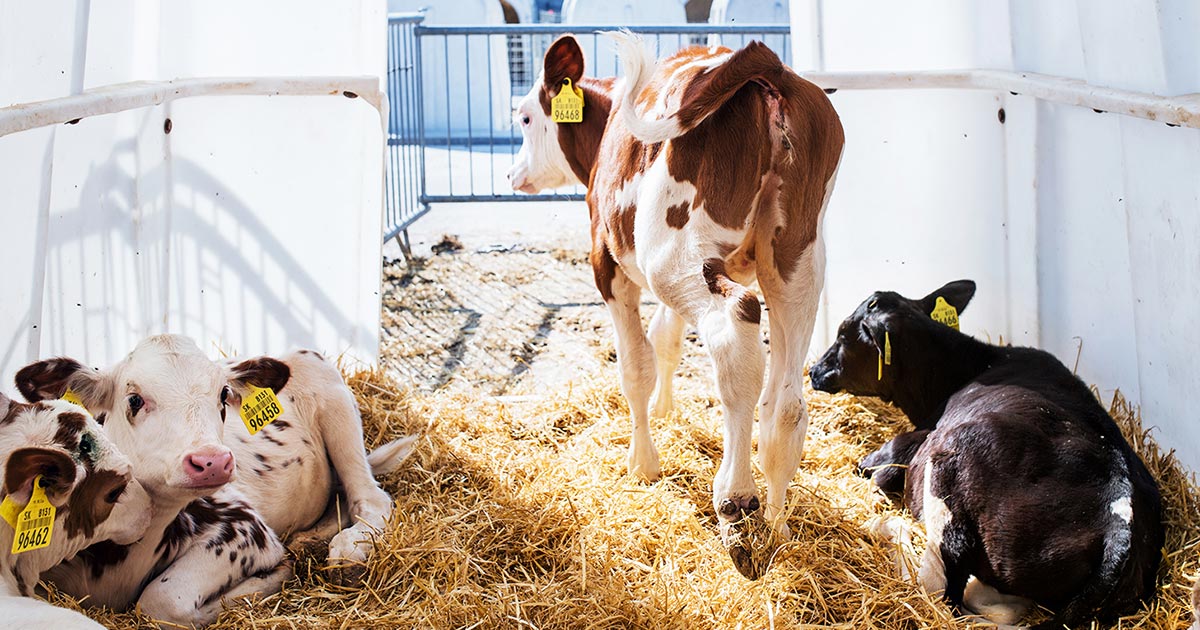29 Mar 2022
Collaborating with farmers to achieve best calving outcomes
Optimum calving doesn’t just happen, and whether in spring or autumn, planning is key. In this article, Navaratnam Partheeban explains how vet and farmer can work together on ensuring the successful birth and rearing of every calf.

The six weeks before calving, and six hours after are vitally important to successful calf rearing. Image © Halfpoint / Adobe Stock

A successful calving does not happen when a calf drops to the floor, but in the six weeks before and six hours after calving. Making use of farmers’ knowledge and experience to collaboratively plan and identify where improvements can be made is key to promoting long-term cow and calf health.
Working closely with farmers to understand the history of their herd and any previous issues around calving provides a solid foundation to be able to make an impact with planning for a successful birth and rearing for every calf. For this reason, when looking ahead to calving, it always pays to ask the farmer plenty of questions.
Remember, it’s not about finding fault with how things have been done previously, but to gain insight into the challenges faced to help tailor the calving plan accordingly.
Plan calving logistics
It sounds incredibly obvious, but to be prepared, farmers need to know when a cow is likely to calf. This is simple for a vet to support with if they’re involved with pregnancy diagnosis, but if not, talking about it with a farmer to get a rough idea is useful. For a farm client, knowing the dates means it is possible to have all facilities to hand, including calving aid, clean water and ropes.
Additionally, it is important to check how the farmer will be monitoring the cows. For spring or autumn calving herds, calving brings an increased labour requirement for a few weeks. Find out whether they have people on hand to support with regularly checking the cows, or if they’ve set up a CCTV monitoring system.
Having these conversations will support the farmer with planning for the calving period and prompt them to make changes that can improve outcomes for their herd and their own mental well-being.
As an example, one of the author’s farm clients, who has a 60-cow pedigree Hereford suckler herd, had a difficult year in 2020, having lost five calves. For him, any loss is a big loss, as they are all valuable calves. With a tight calving period, a sharp increase in labour requirement was coming all at once. As a result, the farmer was missing things like identifying when cows had started calving, so when things went wrong, the emergency call-out was happening too late.
We talked about options for helping to spot developments as they happen. Having seen it work well on other farms, I suggested a CCTV monitoring system that can be watched from a phone, as this can reduce the pressure on everyone as the cows can be checked remotely. The farmer installed a monitoring system, and the following spring didn’t lose any calves.
It is also worth considering the calving area. Calving in individual pens is ideal, as in group pens monitoring can be trickier and expectant mothers can try to steal newly born calves. Think about whether any advice can be given around design for this and bring it up at a point when the farmer has time to consider different approaches, such as when herd health planning.
Prepare the cow
Pre-calving, it is essential to optimise nutrition, making sure cows are neither over-fat or over-thin. For dairy cattle, six weeks before the planned calving date – as the cow enters the transition period – the vet could assess calcium and other metabolic parameters. This is also a good opportunity to make sure vaccinations are done.
Working closely with a farm’s nutritionist is crucial to ensuring calving and post-calving is smooth and uneventful. Generally speaking, vets have an opportunity to reach out to other farm consultants, such as nutritionists, to allow for knowledge to be shared both ways. This is invariably beneficial to all.
Many nutritional products support with disease immunity, so as vets we can support nutritionists by blood sampling – for example, to provide information to support the disease incidence data.
This helps provide evidence that any nutritional intervention is beneficial, or indicates if further tweaks are needed to best support the cows. Similarly, if metabolic disease increases in a herd, the farmer is likely to turn first to the vet, but it is by working with the nutritionist to optimise the transition cows’ diet that we will effectively bring down the levels of disease.
For example, a 1,000-cow dairy herd client the author works with was having issues with mastitis, with 5% to 10% of cows infected with environmental mastitis. The author carried out milk testing and the nutritionist used the results to recommend a nutritional product for transition cows that would help reduce the incidence of mastitis. The changes were made, and within 60 to 70 days the cases of environmental mastitis had halved.
Intervention plan
Even with all the best planning and preparations, on some occasions calving does not go to plan. Having conversations around when to intervene, when to wait and when to call a vet out are, therefore, imperative to avoiding some common pitfalls at calving.
As a rule of thumb, if progress is being made it is best to let the calving continue naturally. It does take a few hours normally, so assisting too early can delay normal progression – especially in heifers. The author usually recommends leaving them undisturbed for a few hours after the early signs of labour.
That said, farm clients should always be encouraged to call the vet if in any doubt. Leaving it too late to check the cow, and, therefore, not realising something is wrong, is often a key factor in poor outcomes. Farmers can provide a lot of information over the phone, so not every concern equates to an emergency call-out.
Find out whether the cervix is open; whether they can feel one head and two feet, or something else; how long the cow has been calving for; and whether it is an averagely conditioned cow.
If a vet is needed on site, communication in emergency situations is key. Share the options with the farmer, recommend the best option based on assessment and explain the reasons for this. Also, trust in a farmer’s knowledge and experience. If they insist on a certain approach, explain the risks clearly, but avoid entering an argument. With livestock, things can go wrong – so learn from poor outcomes and move forwards.
Colostrum management plan
Addressing colostrum management and forming a strategy with a farm client prior to calving is one of the most effective ways to improve calf health and performance. Failure to get 10% bodyweight’s worth of colostrum into the calf within two hours from birth will have a lifelong impact on the animal’s performance.
Remember every hour a calf does not get colostrum, its ability to absorb it decreases. Research indicates that the quality decreases with time, too1.
Colostrum management planning should cover the whole process and be tailored to each farm’s situation and system. Talk through what each farm does straight after a calf is born, consider whether that’s the best way to guarantee that calves receive an adequate amount of colostrum, check if a backup plan is in place if a calf doesn’t suckle and understand if the farmer has a way to measure colostrum quality.
Immunoglobulin G blood sampling a select number of calves is an effective way to make sure they have absorbed enough antibodies. If they haven’t, you will need to investigate whether the problem is with the quality of colostrum coming from the cows, or whether they are not getting adequate colostrum quickly enough.
As an example, 10% to 15% of calves from one of the author’s all-year calving dairy clients was getting early calf diseases, mostly pneumonia or diarrhoea. The farm manager was away a lot, so when the conversation opened about a colostrum management strategy, it was obvious that on this particular farm a clear protocol for the staff team to follow was essential, as the responsibility to implement it lay with them.
We decided to test the colostrum quality of each cow post-calving. If the colostrum is good quality, four litres are delivered to the calf via stomach tube within two hours of birth. Any excess is frozen, so in cases when there is no colostrum or it is poor quality, back-up colostrum is available.
We have already seen the results from the simple management plan for colostrum, as early calf disease levels dropped to 5% within six months.
Hygiene
As with other aspects of calving, getting the basics right with hygiene has a massive impact. So, talking to farm clients about their processes and identifying improvements is crucial. The navel is an obvious entry point for infection. Check how farms are handling navel hygiene. Are they dipping it or spraying it with an appropriate disinfectant?
The area where calves are being born comes into this, too. Find out if calves are being born on to clean or dirty straw and ask about teat hygiene. If they are suckling dirty teats, they are exposed to potential infection from their first feed.
Herd health planning is the best time to have these conversations. It allows a time to sit down with farm clients and take a holistic view of everything they are doing to manage herd health. Calving is a massive factor in this, as the herd plan has sections on calving routine, pre-calving and post-calving management. The right conversations around planning for calving can transform the session from what can feel like a tick box exercise to a valuable conversation that identifies ways to improve a farm business.
Most herds now need a herd health plan. For dairy, it is usually a requirement from their milk buyers, while beef assurance schemes will require an up-to-date health plan.
Use of data and summary
An opportunity exists for more proactive use of data to support and create ideas for what farmers can do to improve calving protocols. It can be used to help vets understand historical occurrences of metabolic disease or difficult calvings. Using the system helps to ensure all services offered by a practice are backed up by data and benefits analysis, which farmers and vets can use when deciding whether a service will be right for their herd.
Finally, remember that successful calving does not happen at the time of calving – it is planned in advance. The six weeks before calving and six hours after are key to determining lifetime performance for the calf and the cow.
